
Micki Chomicki’s studio at Any d’Avray Hair Designs.
The Russell Miller Theater was presenting a musical based on O’Henry’s well-known short story, The Gift of the Magi. Hair plays a crucial role in this tale of young lovers giving each other the perfect Christmas present. The young wife treasures her beautiful long hair, but in a selfless gesture, she sells it to buy a gift for her husband. Since the playwright graciously put the actual haircut offstage, the transition from a long to a short wig was fairly simple, albeit quick. The problem for the hair designer was how to style the wife’s long wig, which she wore for the majority of the show. The narrative moved rapidly through episodic scenes set in a variety of locales; stores, streets, and scenes at home, where the husband makes a point of admiring his wife’s long locks. In the circa 1900 era of the story, a woman would wear her hair up in public. However, if the audience did not see her long flowing locks at home, much of the production’s dramatic impact would be lost. Pausing the action each time the wife needed a wig change would hinder the smooth flow the director desired for the production. Instead, the hair designer worked out a compromise hairstyle based on a turn of the century illustration the costume designer (the author) found. He styled the front of the hair in the soft pompadour bun of the era, but left the back down. To keep the hip-length hair from being too wild, he loosely braided it at the top but let the remainder release into a graceful corkscrew curl.
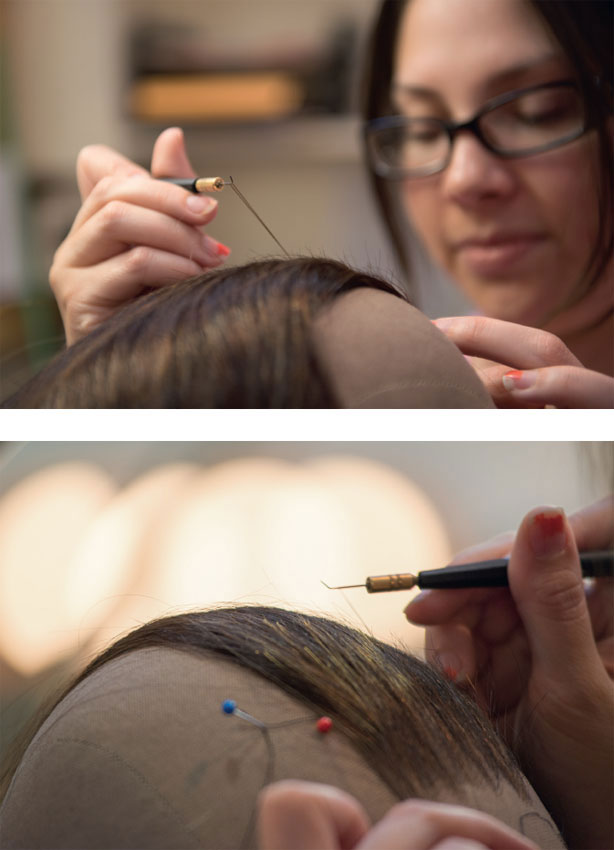
Alexandra O’Reilly knots hair into a wig using a ventilating needle in the wig studio at the Santa Fe Opera.
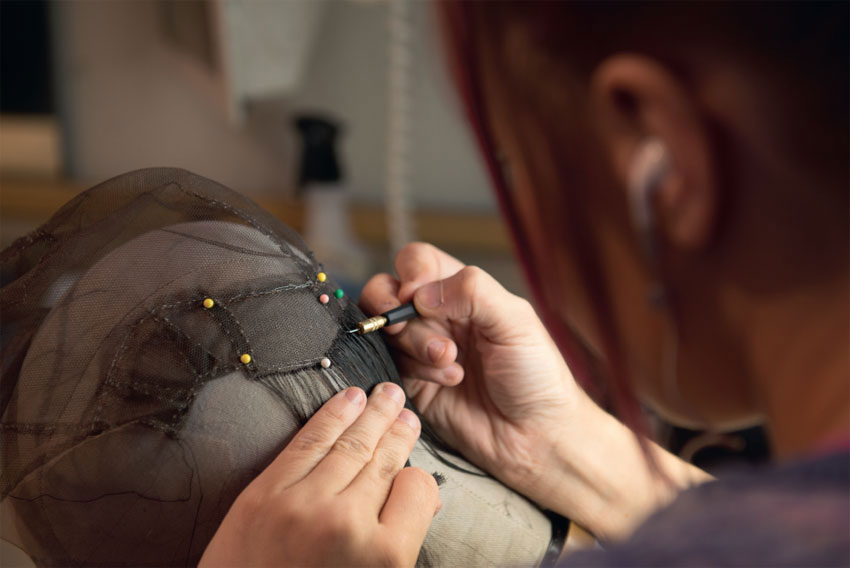
An artisan starts a new wig by adding the first row of hair to a custom head shape made of netting.
Wigs and hair are an independent department from the costume shop, but wig and hair designers work closely with costume designers to develop the total look for the performer. Particularly for period and fantasy productions, the transformation of the performer is incomplete without the hairstyle and facial hair. In most cases, the costume designer develops the take on the character first, and then the hair designer joins the process. Based on the costume designer’s sketches and research, the hair designer creates a more detailed plan for the hairstyles for the show. These specialists also make suggestions to the costume designer about color, length, and style in terms of what might suit the performers, the period, or work well for the characterization.
One of the first decisions the hair designer makes for a show is whether to use the actors’ own hair or to add wigs. For some productions it is all or nothing, for some it varies character by character. The reasons can range from artistic—perhaps the play’s concept demands a highly theatrical look for everyone—to logistic—if a performer has to change looks quickly or needs longer hair or a thicker beard than nature provided. Decisions also are based on resources—both financial and manpower. Is there money to purchase good-quality wigs? Does the theater have a staff that can construct and maintain the needed hairstyles? The highest-budget productions use custom-made wigs, crafted to fit the head shape of each performer, and with each hair tied in by hand. These wigs are the most natural looking, and the highest quality. The mid-price option is to rent high-quality wigs from a custom theatrical wig company, or to buy good-quality fashion wigs made for the mass-market. Those with lesser resources make do with cheaper wigs, but stylists use a wealth of tricks to make these look better than they are, and even in small spaces they can work passably.
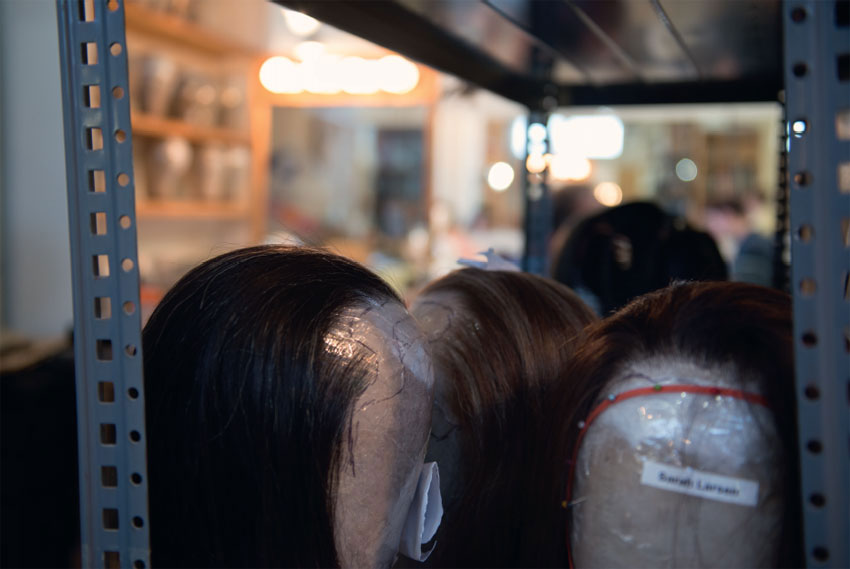
The work of a hair department includes making wigs and facial hairpieces, styling wigs, adding hairpieces or extensions to augment a performer’s own locks, and gluing moustaches and beards to faces. They also style the performers’ own hair, of course. Sometimes the choice to use a wig is based simply on keeping life easier for the performer. If a hairstyle is complicated or very time consuming it is much easier to walk in, pin up one’s hair, and plop a wig on. Of course the hair crew also benefits by not having to do the style from scratch every day.
Sometimes the most difficult wigs are actually the simpler styles. A wealth of imperfections can be hidden under an elaborate arrangement of curls. A basic ponytail, which exposes the whole hairline, is one of the most difficult styles to make believable. A close-cropped style can be difficult over the bulk created by a performer’s hidden long hair, or a microphone pack. (The norm for larger-venue musicals using forehead microphones is to put the mike packs in the wigs so the audience doesn’t see cords snaking up the performers’ necks.)
The process of actually creating a wig entails forming a mesh base tailored to the performer’s head, and then adding in rows and rows of hair. Artisans use a tool shaped like a tiny crochet hook to tie just a few hairs in at a time, a process known as ventilating. The hairline is carefully shaped to be irregular, the soft short hairs a tad unruly. Often the wig artisans use multiple shades of hair to make the effect more natural. In most cases they build a custom wig with real human hair, but sometimes they use synthetic, as the fibers can hold styles longer. After all the hair is attached, it is cut and styled. The wig designer works closely with the hair staff that will maintain the hairstyle daily during the run of the show. The backstage hair staff also helps the performers apply and take off the wigs.
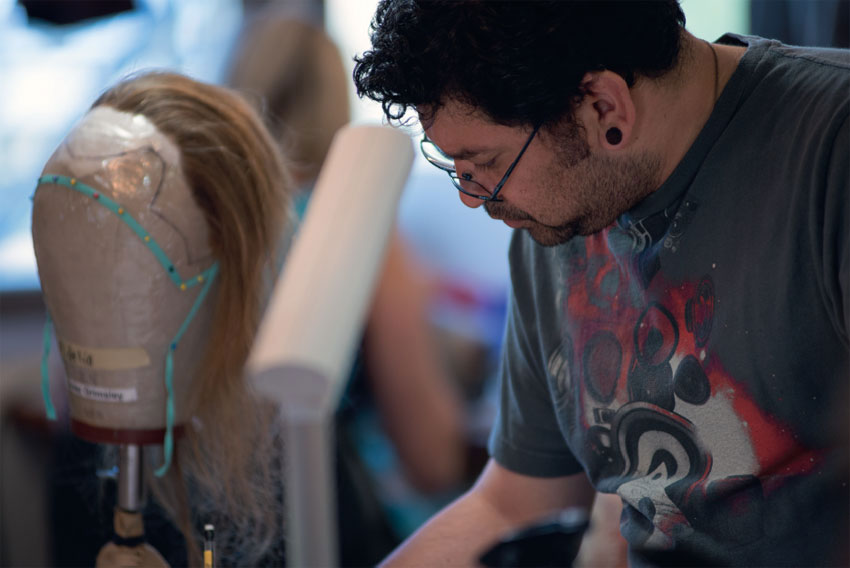
Manuel Jacobo, Staff Artisan at the Santa Fe Opera, with a nearly finished wig.
ROTATING REPERTORY—DAVID ZIMMERMAN
David Zimmerman is Head of Wigs and Makeup at the Santa Fe Opera. He and his team are preparing wigs for five different operas with opening dates staggered over the span of a month. Today is a typically diverse day. Zimmerman meets with the designer of Fidelio, the third opera of the summer, going in detail through her sketches and her research of the opera’s concentration-camp setting. Next he checks in with his staff who have been diligently tying hair at the counters edging the studio for some of the over thirty wigs they will construct this summer. Zimmerman’s own hands are rarely idle: while discussing strategy with his deputy to prioritize the department’s efforts over the coming week, he trims a grayish blonde bowl cut, upping the level of ridicule for an aging Romeo in Don Pasquale. He performs a hands-on check of the chignons several apprentices are styling for the chorus of Carmen, which begins dress rehearsals next week. Next he finesses the cascading curls of a wig for one of the leading ladies who has a costume fitting this afternoon.
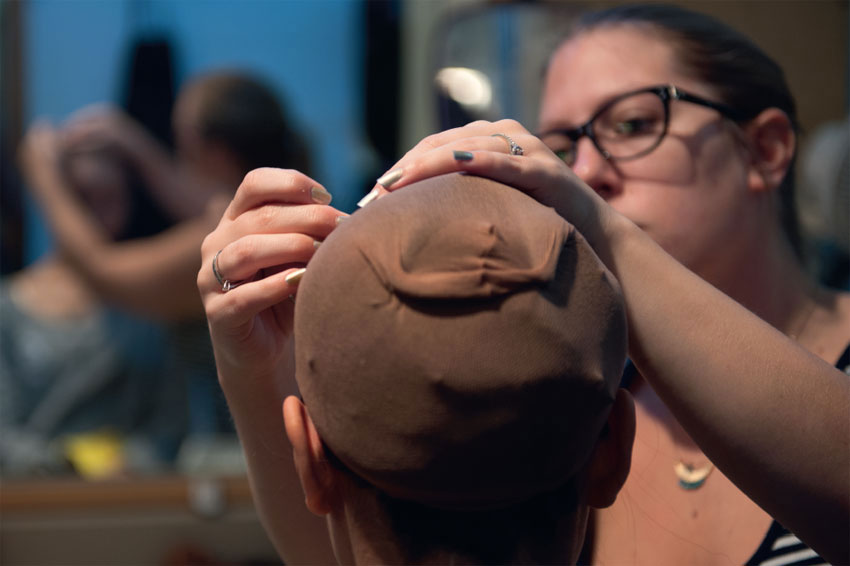
Stephanie Williams, Assistant Wig and Makeup Department Head, puts a wig cap on a performer to secure her hair before she tries on a wig.
Rather than working on Broadway, where the same show runs for months and even years, Zimmerman prefers the rotating repertory schedule of opera companies. “The thing about opera,” he explains, “is that even though you are always going to do a Bohème and a Figaro and a Tosca, they are different productions, they are different people. You are only doing six to twelve performances and then you go to something else.” He divides his time during the year among several cities—Dallas, Santa Fe, and Philadelphia, supervising the opera’s wig department in all three locales during rotating seasons. Although he briefly worked on Broadway, “the same thing eight times a week is really difficult for me.”
While Zimmerman entered college planning to study voice and piano, he decided early on that performance was not in fact what he wanted to pursue, and switched to accounting. Later, while working in corporate administration, he was asked by a fellow church choir member to come help out backstage at an opera, applying body paint to the performers. The head of the department at the Dallas Opera saw both the interest and the talent Zimmerman exhibited, and suggested he seek an apprenticeship in Santa Fe. Zimmerman recalls “I asked him ‘For what?’ Because I had no idea that this was a career—I hadn’t worked in theater, and as a voice major you don’t really know.” Zimmerman dove into his new career and didn’t look back. After two years of apprenticeship, he was offered a position at the Metropolitan Opera in New York. There, he learned on the job under the supervision of hair designer Tom Watson, who at that time was also the head at Santa Fe. Over the years Zimmerman worked his way up, and now he is in charge at the two venues where he got his start, the Dallas Opera and the Santa Fe Opera.
Zimmerman enjoys working with costume designers, whatever their style of collaboration. He is happy when the designer gives him a lot of starting information, as long as his creativity is valued as well. But “sometimes it’s also fun if they give you [a general idea of] what they are going for with their look and then say—well, just do something with that. And then let me just play.” Zimmerman finds that communication is most successful when designers give him not only the sketches, but also research. “The problem is that most costume designers are really good at sketching the bodies and the clothes. Hair… eludes most of them, because it is not an easy thing to draw.”
Research has played a key role in his current collaboration with designer Camille Assaf. This production of the opera Fidelio is set during World War II. A large percentage of the ensemble needs to look like prisoners in the concentration camps. The costume designer used research photos of actual victims, and chose an image to supplement each costume sketch. Zimmerman then had to translate the ideas into something workable for the cast that also preserved the designer’s intent. He thought it would be easier to get the desired effect if they avoided shaved and extremely close-cropped styles on the chorus of women. The singers tend to have longer hair, and the amount of time it would take to get their hair smooth and skull-shaped under nearly bald wigs didn’t seem a good use of resources. Assaf agreed. Instead, he explains, “a lot of the women in Fidelio are going to end up with some of my medium-length men’s wigs and we will make them dirty and messy and look choppy and so that’s how we will take care of that.”
For the first show of the summer, Carmen, Zimmerman also felt very included in the creative process. He took his cues from the research and from the hairstyle shapes in the watercolor sketches. Designer Jorge Jara “had it all broken down by character. We’d talk about it and we’d work through [the designs] together. It’s a process… some of it has come from me, some of it has come from him.” Furthermore, since many of the costumes were assembled from vintage clothing and accessories, subtle shifts happened between the sketches and the finished costume. He kept in communication with Jara to ensure they were on the same page, and took cues from the preliminary fitting photos, which showed the singers in the actual costumes. From the pictures, he made adjustments like, “Oh, well they’re a little seedier than we thought—maybe they should have some greasy stringy long hair.”
In the job of a hair and wig designer, collaboration with the performers is at least as important as collaboration with the costume designer. Hairstylists spend a lot of time with performers and “any time you get that close to someone’s head they have a lot of opinions and ideas.” He adds smiling that “I also have to be a little bit of a therapist on occasion because… I’m like a really close-in bartender. I am literally ten inches from their face and you’d be surprised at the secrets you get when you get that close.” Zimmerman feels that his background in performance and his understanding of the stress of being onstage give him an instant rapport with the singers. If a performer is not onboard with the hairstyle, he explains the reasoning behind the design choices. Taking the time for discussion gives the performers confidence in him, and ensures they understand “that I will never make them look bad unless it’s deliberate.” If he thinks a singer has a valid reason for requesting a change in a design, he will make the case to the costume designer or director. A good rapport also serves him well when he needs to persuade someone to go outside his or her comfort zone. A well-known mezzo-soprano he worked with who loves to be glamorous was playing a frumpy old maid character, complete with nerdy glasses. He bargained with her, since they had another upcoming show together. “She was going to be royalty and she said that she didn’t mind if we do this [unglamorous look] here as long as I remembered next time she was the pretty one. And we did. She was one step away from a drag queen,” he says impishly.
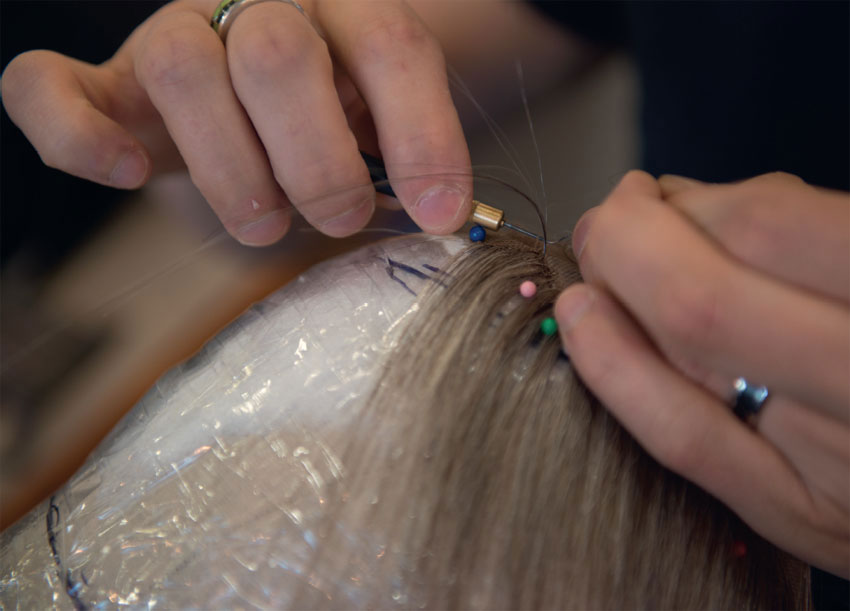
Varying shades of blonde are used to make a wig look more natural.
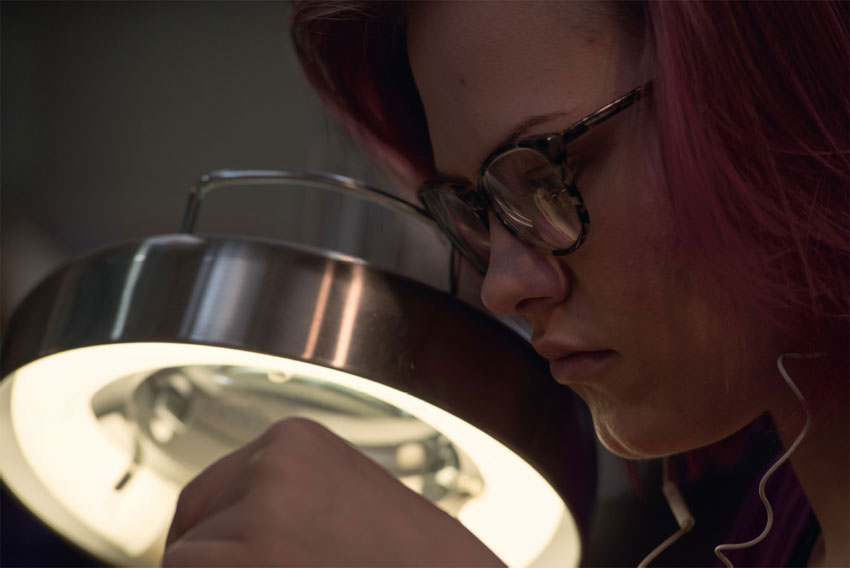
Ashley Robinson concentrating on her work.
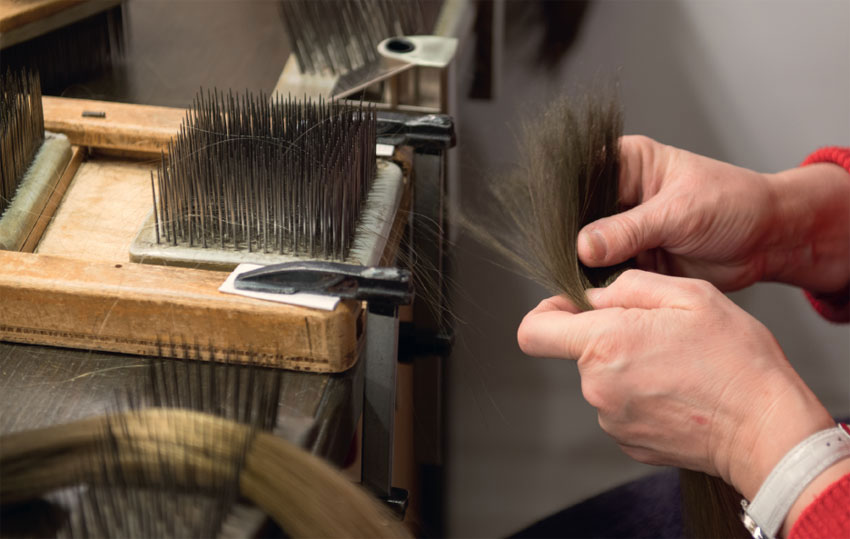
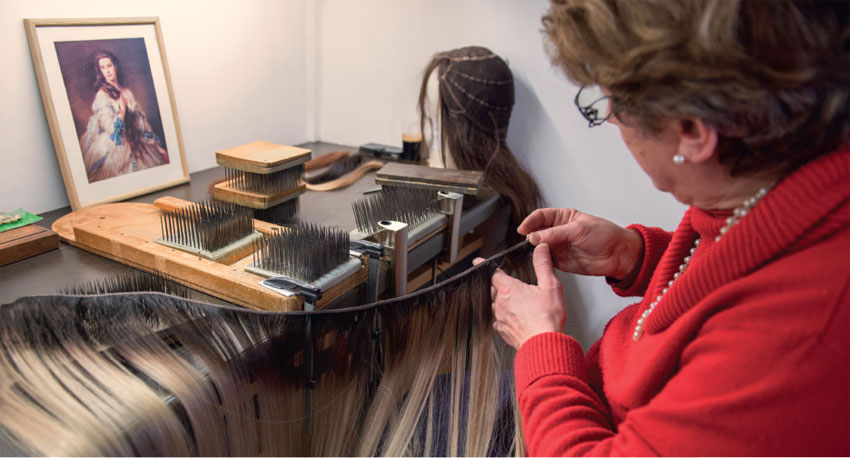
Above and opposite: Carmen Mardelle, a worker at Any d’Avray, prepares hair custom-dyed to have dark roots. She detaches it from the binding at the top, and pulls it through the spikes to comb and organize it.
THE DANGER OF LIVE PERFORMANCE—CHRISTINE “MICKI” CHOMICKI
Christine “Micki” Chomicki clamps the canvas wig head to the end of her worktable, and carefully parts the strands of tousled brown hair until she finds the damaged section. Hairstylists for a music video, unused to handling quality wigs, have treated this one a bit too much like a real head of hair. While human-hair wigs can be brushed and styled, the delicate mesh anchoring the hair is much less forgiving than a human scalp. She threads a curved needle with a matching shade of brown, and closes up the wound like a surgeon. While she stitches, she glances across the room at an intern, who is attempting her first solo project. The novice anchors a section of netting over the outline of a moustache. Chomicki comes over and runs her finger across it. She chastises the nervous girl that the netting is stretched too tightly, and the ventilating hook will tear it when she knots in the strands of hair. As the intern sadly removes the pins, Chomicki snags an espresso from her desk, and returns to her perch in the corner of the room.
Chomicki’s work spans theater, opera, film, television, and fashion. She created wigs for a campaign for Chanel Number 5, and was “very honored” to be asked to restore a vintage wig complete with feathered headdress belonging to Jacqueline de Ribes for an upcoming exhibit at the Metropolitan Museum’s Costume Institute. Despite her evident pride in having such high-profile clients, her favorite projects are for live performance in any genre. She likes the “danger” of it, and the challenge of creating wigs and hairstyles that have to last through two hours of acting, dancing, and rapid changes. The logistical problem solving appeals to her, but she knows it must fade to the background onstage. “We try to be sure technical considerations never get in the way of the art.”
Chomicki believes “the wig is the end of the costume, like punctuation,” and so close collaboration with costume designers is integral to her own creative process. When Chomicki meets with costume designers, she asks them to explain their overall vision, even before showing the sketches and research. “I need them to tell me a story,” she says simply. She prefers to work with designers who value her artistic contributions. “I don’t want to just be a service. I like to be considered an artist on the same level.” However, she has also enjoyed projects with designers who decide every detail, such as fashion’s Thierry Mugler. The technical challenge of realizing Mugler’s intricate designs is enough to hold her interest. For any production, the clothing and wig have to create a coherent whole. She cannot judge her success without seeing the full effect, so she prefers to fit wigs on performers while they are in costume.
Chomicki first studied fine arts for three years at the school of Beaux Arts in Marseilles, where she gained a classical foundation in drawing and sculpture. Afterwards she went to makeup school, but not because of an interest in fashion or beauty. She was drawn to the character side of makeup, having “always wanted to transform people,” and studied special effects. She worked successfully as a makeup artist for some years. As part of the job, she applied facial hair and wigs to her subjects, and became more and more interested in the craft. She visited wig studios, picked up the basics, and then taught herself from there.
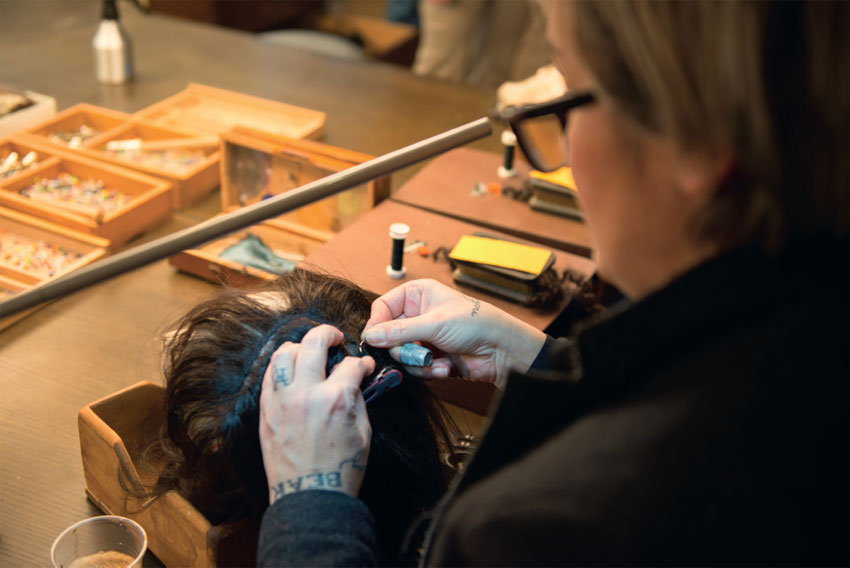
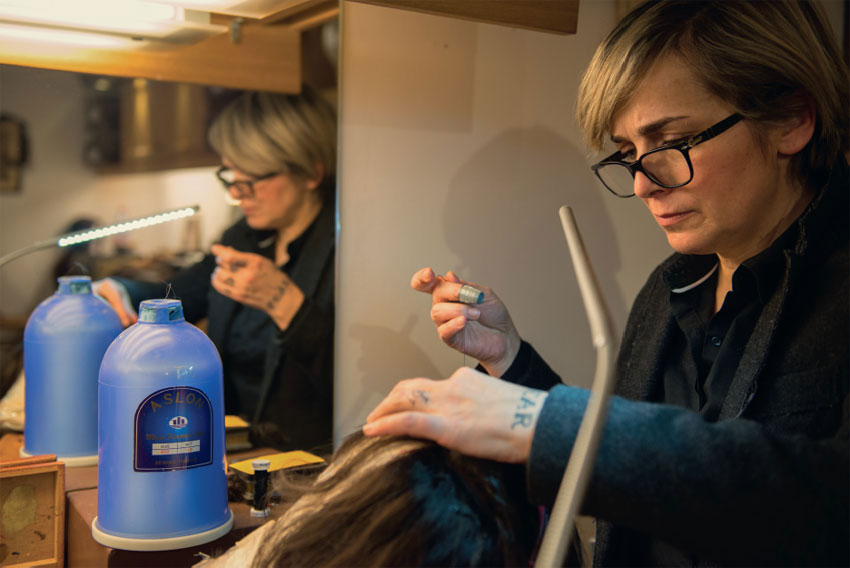
Above and opposite: Micki Chomicki repairs a wig using a curved needle.
Chomicki currently runs the “Spectacle” (performance) division of Any d’Avray Hair Design, a high-end wig company based in Paris’ chic Opéra District. While her department designs and creates wigs, hairpieces, and facial hair for a range of stage and screen projects, she considers large musicals her specialty. She just completed Singing in the Rain with costume designer Anthony Powell at Théâtre du Châtelet in Paris. For such projects, she pulls together a team of artisans who can create quality wigs on a tight schedule.
She likes the challenge of designing and coordinating over two hundred wigs. Choruses typically have at least twenty men and women, each playing multiple roles. When the actors leave the stage, they have very little time, often well under a minute, to change outfits and wigs. Chomicki and her pre-production team choose the wigs and create the initial styles, and then work closely with the team of stylists who will put the wigs on the performers, do changes, and maintain the looks throughout the run of the show.
Rising to a challenge is what keeps the business fresh for Chomicki. Her career goal is to continue to astound and surprise people. These challenges take many forms, from extreme realism to elaborate sculpture. One of the hardest projects she ever undertook was creating a wig for the French version of the reality show Undercover Boss. She had to disguise the subject so that he could go unnoticed by his employees. While wigs for television and film are ready for camera close-ups, actual real life brings a whole other level of scrutiny. Adding to the difficulty was the fact that the “boss” had to be able to put the wig on unassisted, with no professional hair and makeup people on hand to finesse the look.
A memorable project at the other end of the spectrum was the operetta Veronique directed by actress Fanny Ardant at Théâtre du Châtelet. The costumes drew from the colorful 1950s style of Vincente Minnelli films, with an extravagant New Look silhouette. While discussing the designs, Ardant asked what hairstyle would complement the flamboyant vamp character of one of the women. Without thinking, Chomicki muttered that she needed an Eiffel Tower. For a French hairstylist, an Eiffel Tower is a term for a tall, elaborate hairstyle. However, Ardant took her literally, and found the idea perfect. So, Chomicki had to swallow her chagrin and find a solution. She hired a model maker to sculpt a base for the tower in clear resin. Then, to more easily attach the hair, she covered it in netting to provide texture. She glued braids in an elaborate pattern to the surface. The four legs of the tower cupped the actress’ head and held the heavy structure securely while she danced.

Chomicki looks across the studio as Margot Arabian, a worker at Any d’Avray, prepares a section of custom-dyed two-tone hair.
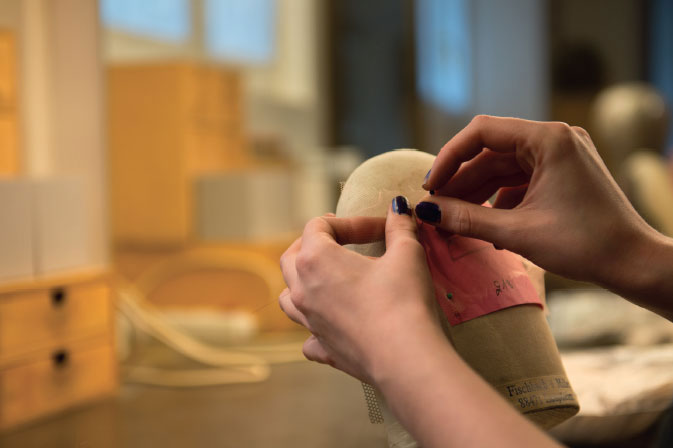
An intern pins netting over the outline of a moustache on paper.
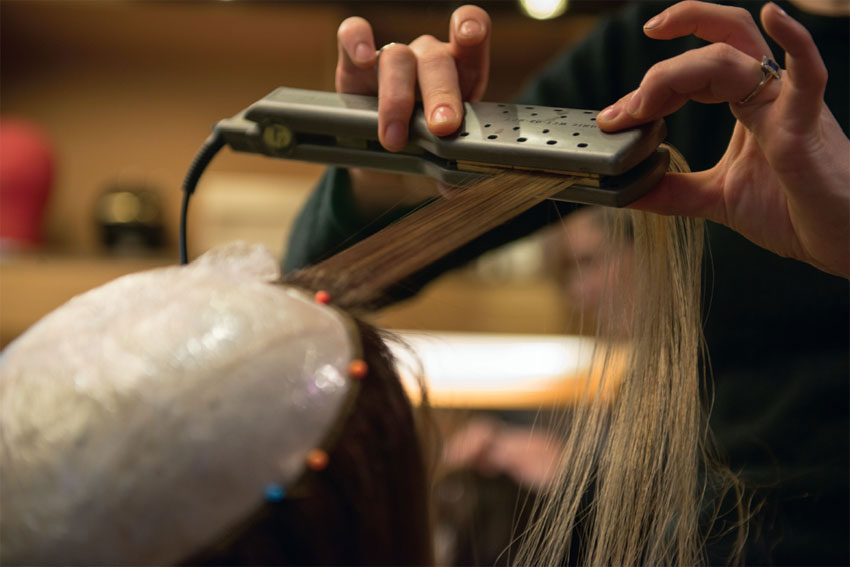
A close-up as Arabian uses a straightening iron to smooth the two-tone hair.
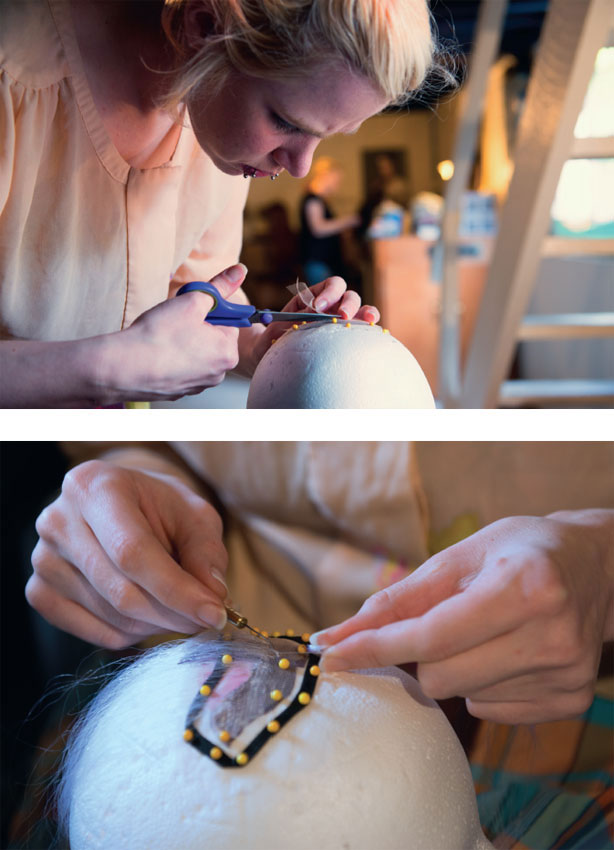
Hannah Wold, Associate Wig Builder at Custom Wig Company, trims netting and knots hair into a moustache.
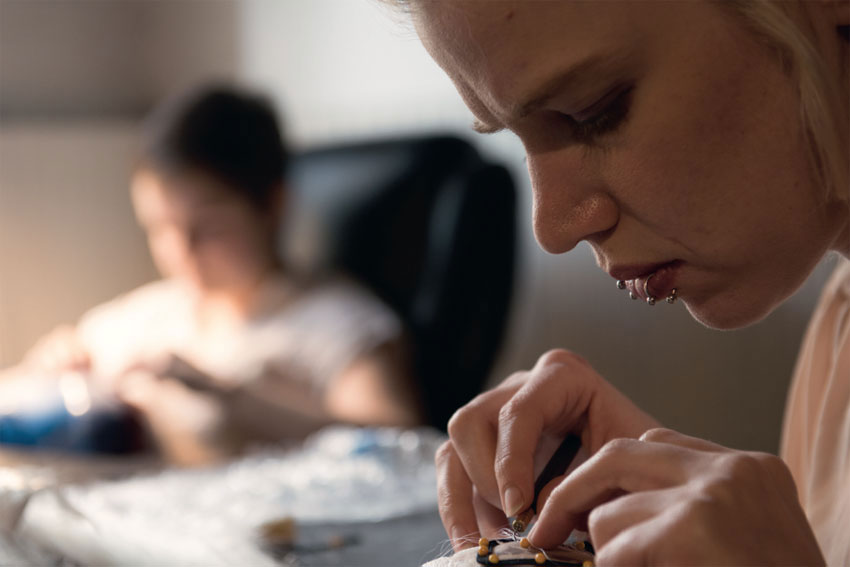
FINDING THE CONTEXT—HEATHER FLEMING
For Heather Fleming, wigs are a vital part of theater’s storytelling. The choices that people make about their appearance and grooming tell a lot, and both the look and the function of the wig can help to convey personality, or further the meaning of a scene. She feels lucky to have worked for collaborative companies where she was able to make suggestions to designers, actors, and directors about using hairstyles to contribute to the success of the show. “I like that you make that connection with the actor and their character work in a really intimate and specific way.” Just like with costume design, hair design must be geared to the specific person who will be in the role. Although prep work for a show frequently happens before casting, “It’s all theory until you get an actor.”
Fleming honed her collaboration skills as the wig master for jam-packed seasons of repertory. While she roughs in the styles on wig heads, “I like to finalize the style on the actor. Of course it’s going to need to be adjusted… Don’t get attached to it until opening night!” She wants both the actor and the costume designer to feel comfortable giving input during the fitting. If the style is too finished, it’s hard to make changes on the fly. The fitting is also a time to get actors comfortable with the idea that the wig is a tool they can use. While actors must respect the limitations of a wig, “if they can’t behave with it like the character would behave with their own hair, then my work is too precious.” Even a fitting can only get a wig’s style partway to completion. After seeing the wig in context onstage, designers and directors often want changes, either to finesse visuals or to solve logistical issues that arise.
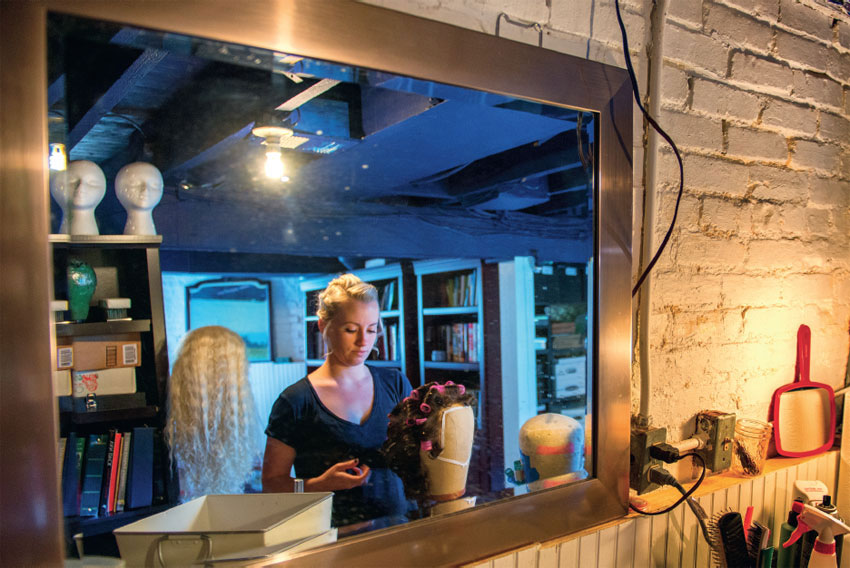
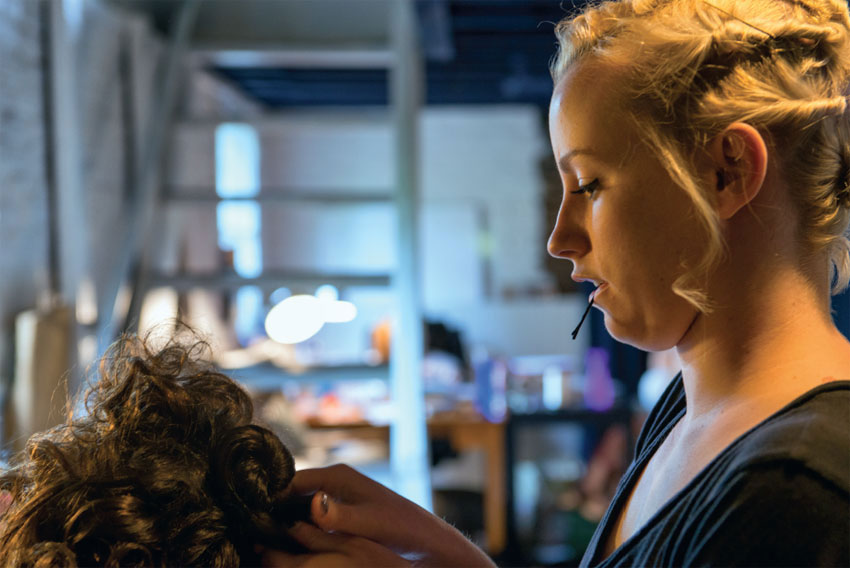
Above and opposite: Meredith Stein, Associate Wig Builder, takes a wig out of rollers and prepares to style a Regency era up-do.
Often logistical problem solving can lead to an interesting artistic idea. For a production of Dracula at Actors Theatre of Louisville, the creative team decided that the character of the doctor’s assistant should have her hair down in the final scene where she is “bloody and damaged” to make it as dramatic as possible. They worked backwards to figure out when the hair of a properly dressed nineteenth-century woman might come down. They hit upon the idea of having the actor who played Dracula take the assistant’s hair out of its bun during a previous scene, which created an interesting theatrical moment. In this era a woman wore her hair up in public, so “it was very sinister, and very violating, that he was taking this liberty with her person,” Fleming explains. To make the bun unfurl dramatically, Fleming had to do some problem solving. First she had to work out the actual hairstyle that would look best for the actress and character. Luckily a simple bun was appropriate for a doctor’s assistant, because for the moment to be dramatic and not comic the up-do had to be secured with as few pins as possible, but still stay up for most of the show. After some trials, she found it worked best if the actress discreetly pulled out a few pins in the scene just before. Fleming also had to decide the best way to roll and twist the hair so it fell smoothly. Next, “we had to teach the actor who was doing Dracula which pin to pull out when, and how to handle it so that it seemed deliberate.”
Fleming became interested in costumes early, and during her undergraduate training she settled on the production side. She selected the University of Illinois for the costume technology masters program, planning on a career in draping, millinery, or crafts. By chance, she was assigned an assistantship in wigs. As she pursued the intensive graduate courses, she realized that her sewing and draping abilities were not strong enough to make her viable in that profession. And, at the same time, she discovered that she both enjoyed and had an aptitude for wigs. During her first year of school, she learned under the university’s full-time wig master. However, the wig master left the following year, and she was asked to run the department. “It was terrifying, but it was exciting too… so for me that cemented that this was what I wanted to do with my career.” After graduate school, she took a position at the Barter Theatre in Virginia, and from there she became wig master at Actors Theatre of Louisville. She now runs her own wig styling company, and continues to work as a wig designer for several nearby theaters. She enjoys being a less noticeable member of the production team. In fact, she says that the best compliment she ever received was when the reviewer of a show questioned her wig design credit in the program, because he hadn’t seen any wigs. Actually, there were four.
One of her proudest accomplishments was for another show at Actors Theatre: the yearly production of A Christmas Carol. The costume for the Ghost of Christmas Past presented “a trifecta—a quick change, a styling challenge, and a design challenge.” The first hurdle was figuring out what the hairstyle should look like. The ghost wore a silvery unitard, which gave no reference to a time period or culture. Fleming had to figure out “what kind of hair does a formless spirit have?” She thought maybe the character could evoke Scrooge’s mother. Although the audience would not explicitly realize this, the idea gave her a foundation.
She picked a hairstyle that suggested the late eighteenth century, and decided that silvery white would make a nice contrast with the actress’ youth. The next wrinkle in the process was when the actress cast in the role turned out to have a circus background, and so the director added aerial silks into her performance. Suddenly, safety became a huge imperative. Fleming scaled down the size of the hairdo, to be sure that nothing could throw off her balance or get tangled in the silks.
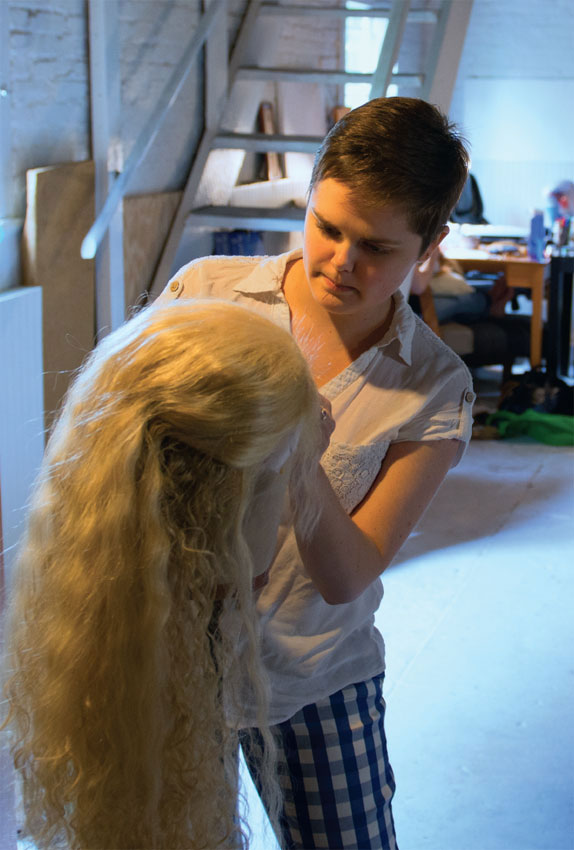
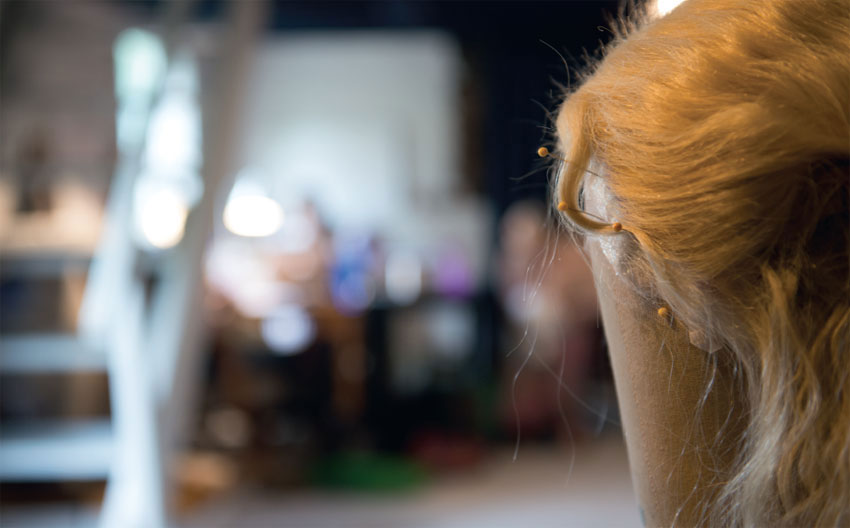
Above and opposite: Hannah Stoppel, Lead Wig Builder, puts the finishing touches on a loose, blonde style at Custom Wig Company. The pins help hold a wave in the perfect shape as it sets.
The next addition was a wireless microphone, to add a reverb effect into the actress’ voice. For safety, the wire could not be exposed, which meant putting the mike pack into her wig. While this is a common place to put them, the wig needs to be built specifically to accommodate the battery pack. Fleming was too far along with the show to have either the time or the money to make a new wig. “Mike packs are only the size of a bar of soap but that’s a lot to try to put into a head,” she explains, so it had to attach to the outside of the wig, hidden in the bun. The pack also had to be easily accessible to the sound technicians, who check the batteries before every performance, so its lodging could not be permanent. She attached a pocket securely to the wig, and added an extra piece with curls over it to ensure the square-edged lump was truly hidden. As a final complication, the actress played other roles in the show, and had a very short time to get into wig, costume, and makeup for her ghost character. The backstage crew had to quickly secure the wig to the actress, but so well that even with the extra weight of the batteries it would stay on through all the flips and spins. They choreographed the change hairpin by hairpin, and Fleming added face-framing curls to hide the edge of the mesh, in case there was not time to glue it down perfectly to her forehead. Overall, “it was one of those things where this poor wig is having to do a lot of work, but it’s totally worth it.”
Wigs provide an important finishing touch to the character onstage, and a costume for the head. A short scruffy beard on Hamlet shows his growing distance from the court society; the blonde pixie cut on Maria keeps the novice nun attractive but wholesome. Perhaps even more than with costumes, when wigs are done well, they are imperceptible. And, if there is a problem, it can be incredibly distracting. A “wiggy” looking wig or a moustache coming unglued onstage can ruin a show like nothing else. Occasionally the hair gets to steal the scene, and then these artists show off their prowess constructing a towering beehive or an extravagantly twirled moustache.
